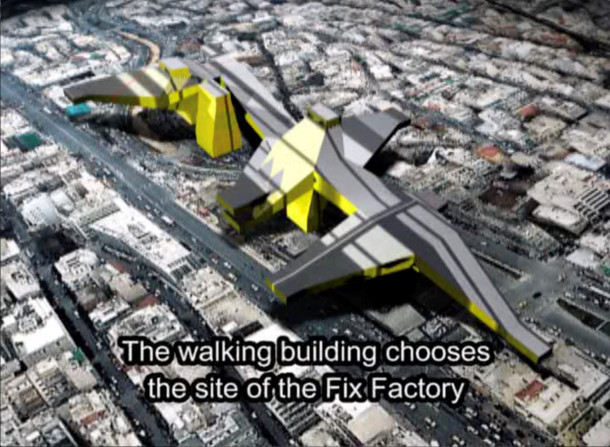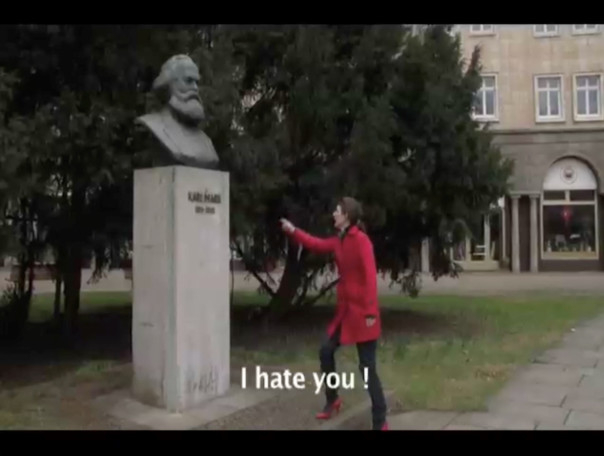We are living in a world where the rapid pace of technological development is changing our lives and our environment in so many ways and so quickly that it is important for us to pause and think about how the choices that we make today will impact our future. Adapt to Survive: Notes from the Future is an exhibition that invites viewers to do just that by presenting a vision of what our future might look like as imagined by seven international artists.
The show, hosted by Concrete at Alserkal Avenue in collaboration with the Hayward Gallery, London is curated by Dr Cliff Lauson, the gallery’s senior curator and opened at the gallery’s HENI Project Space in London’s Southbank Centre earlier this year. It’s title, Adapt to Survive, is a phrase much used in recent times in the business and technology sectors. It is a contemporary adaptation of Darwin’s theory of evolution and natural selection for a world where human beings have the technology to change their environment and people and businesses are learning to adapt quickly to survive in a rapidly evolving environment.
“In recent decades, futurology has become a significant area of research, and futurologists and professional change-makers are using statistics, game and systems theories, and speculation to predict technological advances, new social norms and changes in market forces. Responding to these cultural shifts, the artists in this show have made educated guesses about our society’s evolution and progression, but their artworks also convey uncertainty and scepticism about our accelerating patterns of growth and consumption. The show asks what decisions we can make to steer us more carefully as we are propelled into the future. “This is Hayward Gallery’s first international exhibition and we are delighted to collaborate with Concrete and bring it to a global audience in a city that is constantly looking to the future and will soon have a Museum of the Future,” Lauson says.
This is Hayward Gallery’s first international exhibition and we are delighted to collaborate with Concrete and
bring it to a global audience in a city that is constantly looking to the future and will soon have a Museum of the Future.
The seven artists in the show have examined different facets of life — ranging from architecture, technology and the environment to politics, language and biology — to create works that articulate their vision of how our society will evolve and progress. Their artworks include films, sculpture, installations and text-based works that present fantastical as well as dystopian views of the future. While some artists have looked just a few decades ahead, others have let their imaginations wander millions of years from now.
Rainer Ganahl’s short film, I Hate Karl Marx, is set in the year 2045 in a world where China is the dominant political and economic power, everyone speaks Chinese, and Marxism has spread across the world. It features a young, very emotional German woman standing in front of a statue of Karl Marx in Berlin, surrounded by shops with Chinese signage, bitterly complaining about the loss of her culture and how much she hates speaking Chinese, eating Chinese food, driving Chinese made cars and living by the laws of the Chinese communist party. The humorous, thought-provoking film is part of the New York based Austrian artist’s ongoing engagement with non-Western cultures. It addresses Western xenophobia, offering an alternative, but plausible vision of the world that is in stark contrast to the current dominance of Western capitalism and the English language.
Welsh artist Bedwyr Williams has created a high definition digital matte painting of an imaginary mega-city in rural North Wales in 2050 using digital film-making techniques. The 20-minute film simulates a 24-hour time period in the city. Although the inhabitants are not seen, fragments of their conversations can be heard stitching together micro-narratives about the design of the city and the daily routine of the residents revealing the monotony and listlessness of their lives. The work is named Tyrrau Mawr (The Big Towers) after a lower summit of the Cadair Idris mountain and reflects on urban planning and the place of the individual in society.
Similarly, New York-based Lebanese artist and writer Youmna Chlala has brought together snippets of the thoughts of survivors from a failed utopian city in Norway in 2077, in her multi-media work, The Butterfly Already Exists in the Caterpillar. The work is part of her ongoing project, The Museum of Future Memories and features vinyl drawings, water colour paintings, assemblages, texts and video projections that were inspired by the city of Fornebu in Norway, which used to be a national airport that was replaced by a tech city and has now become a luxury housing complex. The work presents a narrative about a city in flux, and how its inhabitants are adapting to the changes and redefining their relationship to their sense of place, their community and history.
In his animated video The Walking Building, Greek artist Andreas Angelidakis has imagined the contemporary museum of the future as a shape-shifting structure that responds to the needs of today’s mobile, digitally connected artists by adapting to different environments and requirements. His video shows a hybrid hyper-building that comes alive, crawling on multiple legs through the streets of Athens. The artist was inspired by the radical, adaptable urban structures proposed in the 1960s by avant-garde architectural collective, Archigram, three of whose founding members were involved in designing the Hayward Gallery.
Julian Charriére’s beautiful architectural sculpture from his Future Fossil Spaces series draws attention to our relationship with the planet’s natural resources and the geological impact of our increasingly digital and consumerist society. The Berlin-based French-Swiss artist has constructed hexagonal columns with salt bricks from the Salar de Uyuni, the world’s largest salt flats located in Bolivia. In between the bricks are some acrylic containers filled with lithium brine creating gaps in the structures that represent the spaces left behind in the salt plains after the extraction of lithium, mined for use in batteries and other electronic components. The work, which contrasts geological time with ‘digital time’ is a new iteration done specially for Concrete of a sculpture presented by the artist at the 57th Venice Biennale.
London-based French artist Marguerite Humeau’s work explores contemporary manifestations of ancient myths. Her sculpture in this show, Harry II, reimagines the sphinx — the half beast half human gatekeeper of ancient Egyptian and Greek mythology in the modern context of online security, border control and surveillance. The sculpture features a three-faced winged beast surrounded by anti-climb raptor fencing cast in artificial human skin, tanks filled with artificial blood, and an artificial blood-sucking organ. The sinister, seemingly organic presence conjures the possibility of a time when humanity will be devoured by a superior creature.
Danish-Norwegian artist Ann Lislegaard’s installation, Time Machine, references the book of the same name written by H. G. Wells in 1895, which was one of the earliest works of science fiction and the first to explore the idea of space and time travel. The work features a time-travelling fox that has just landed in the gallery in a mirrored vessel to deliver a message from the future. The computer-animated creature’s crazed expression, agitated movements and glitchy monologue comprising excerpts from Wells’ book suggest that it is on the brink of a breakdown, indicating that the future is as flawed as the present.
The show is accompanied by a public programme of talks, workshops and performances led by the participating artists.
Abdelmonem Bin Eisa Alserkal, founder of Alserkal Avenue and Concrete, says, “Concrete was envisioned as a space to host international, museum-grade exhibitions that support cultural understanding. This collaboration with the Hayward Gallery, London, brings to the UAE diverse views of our shared future, creating a foundation for an imperative discourse around sustainability and futurology, subjects that are now central to our rapidly-changing world.”
Jyoti Kalsi is an arts-enthusiast based in Dubai.
Adapt to Survive: Notes from the Future will run at Concrete, Alserkal Avenue, Al Quoz, until November 21.



_-_Bedwyr_Williams_16a0851c4d1_large.jpg)











